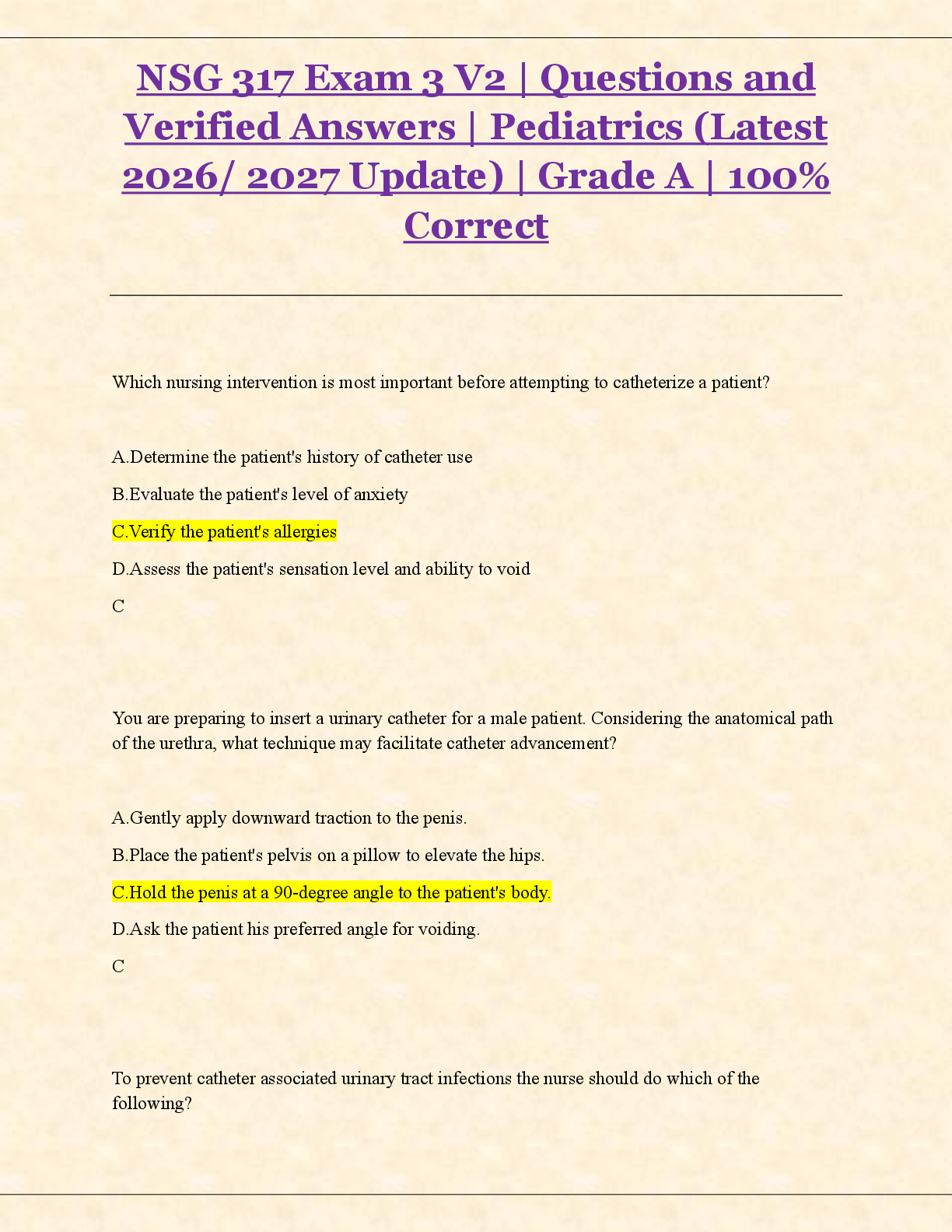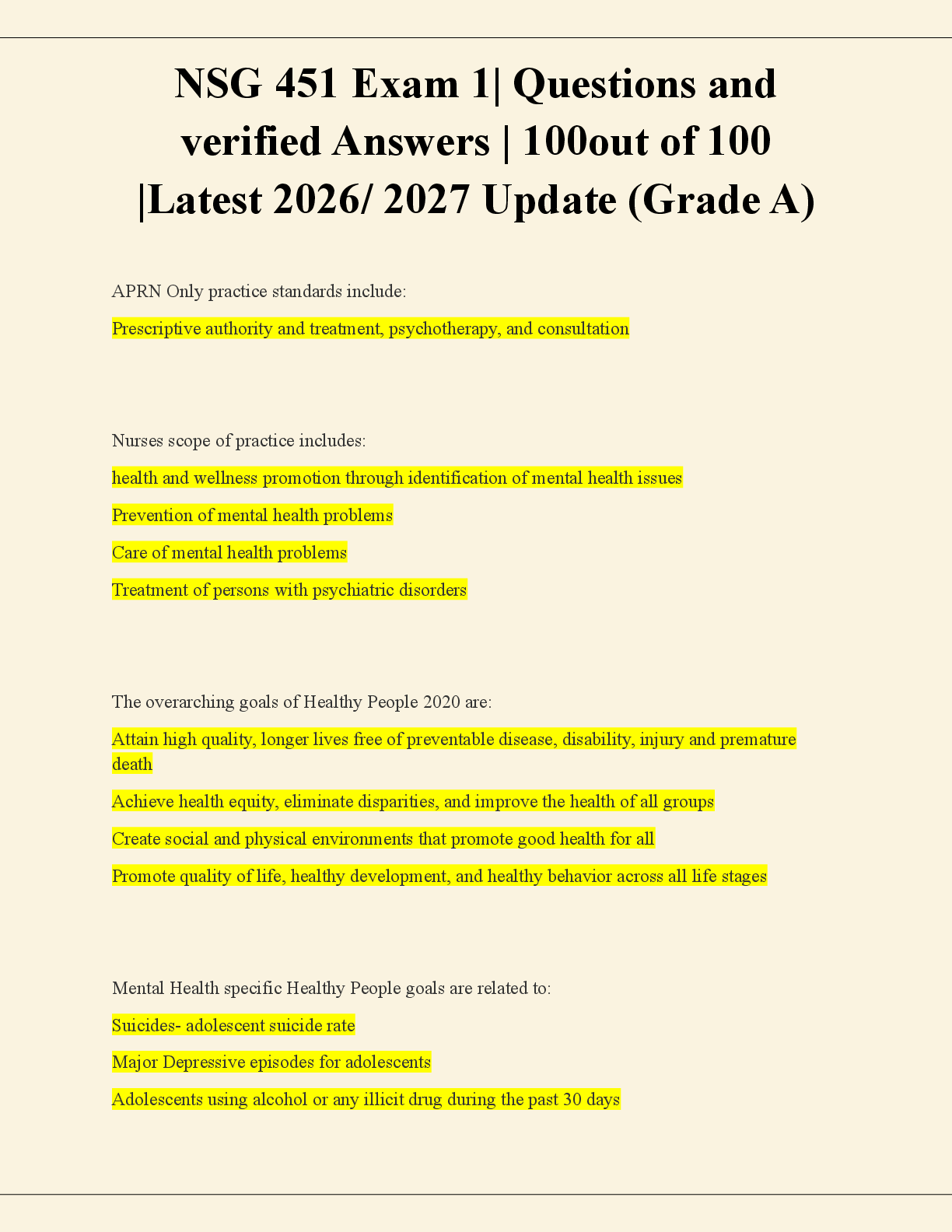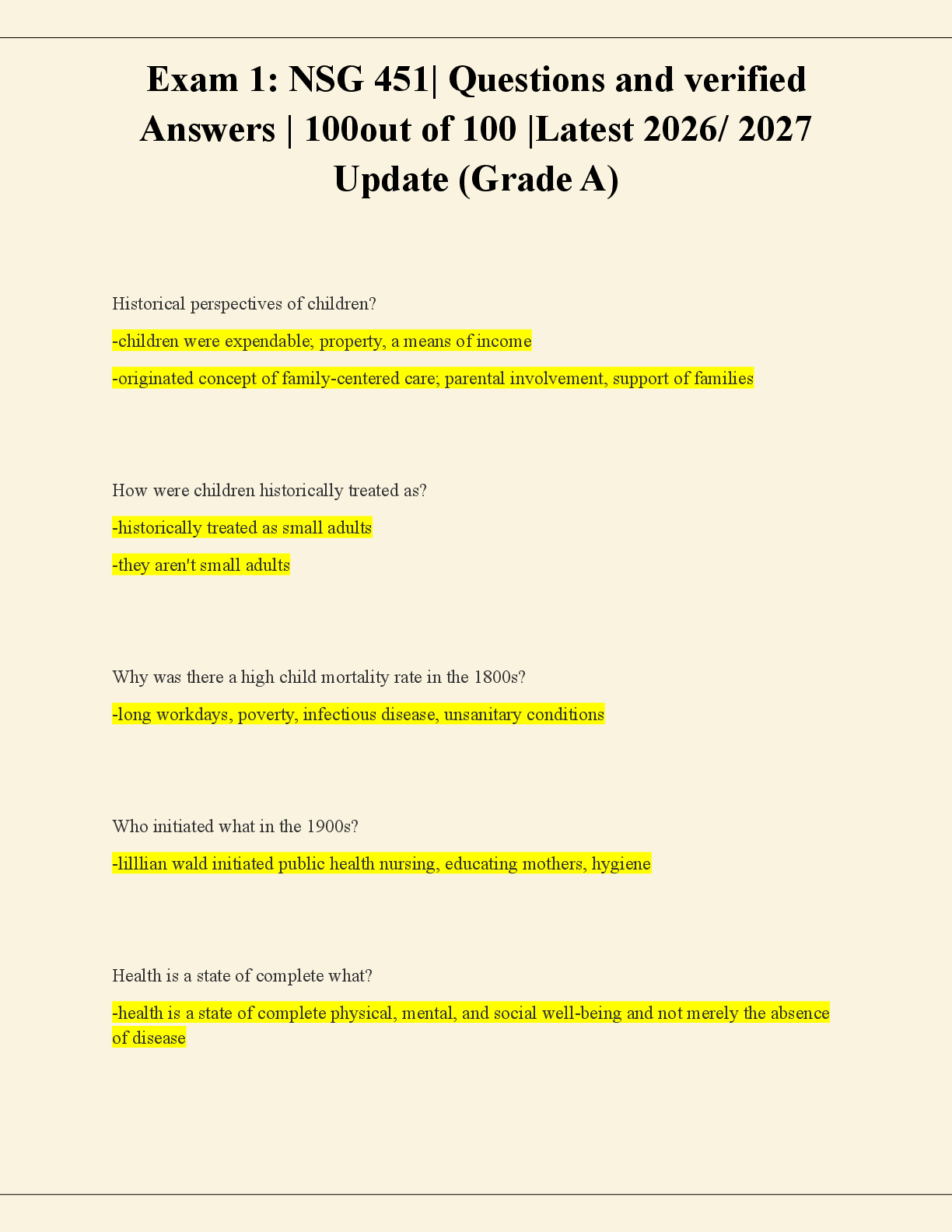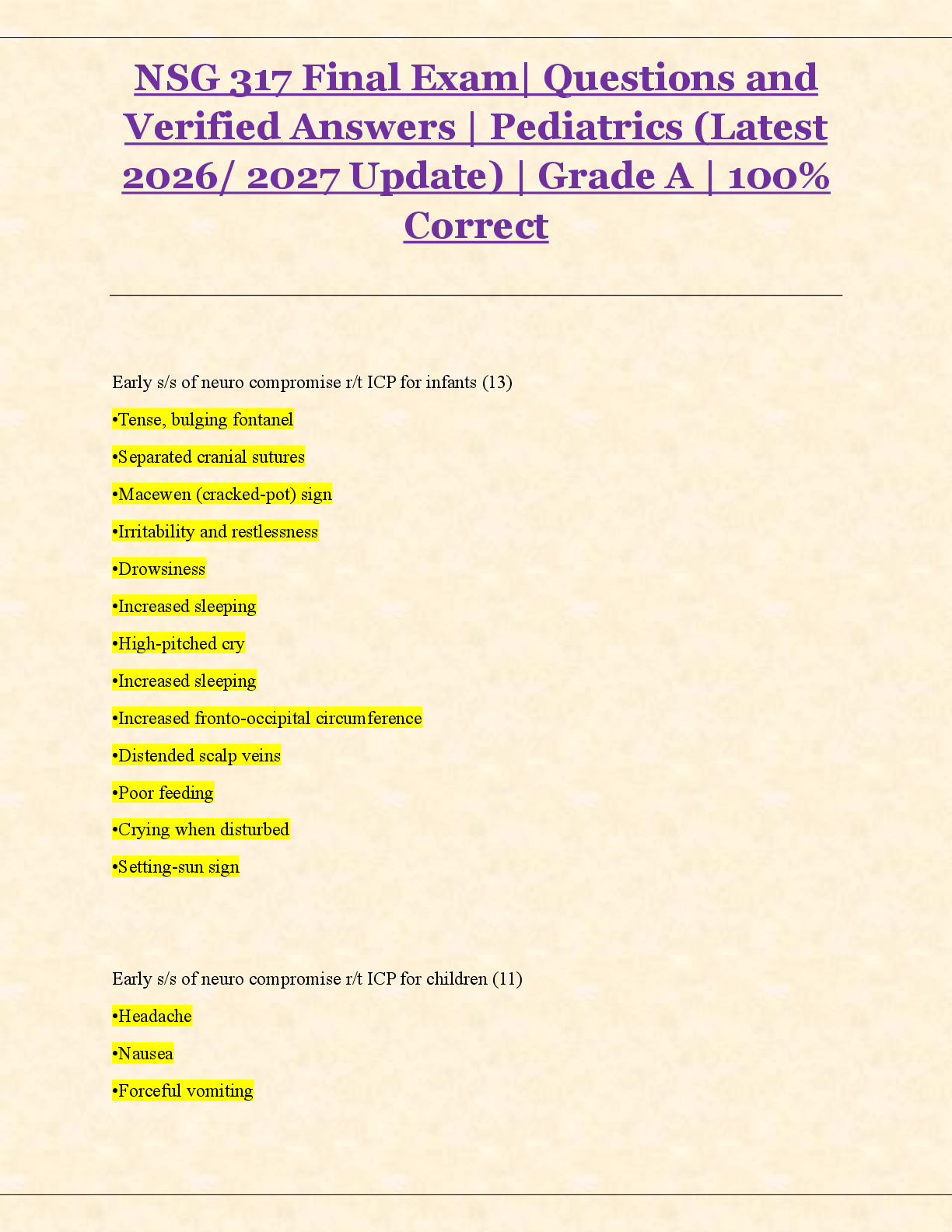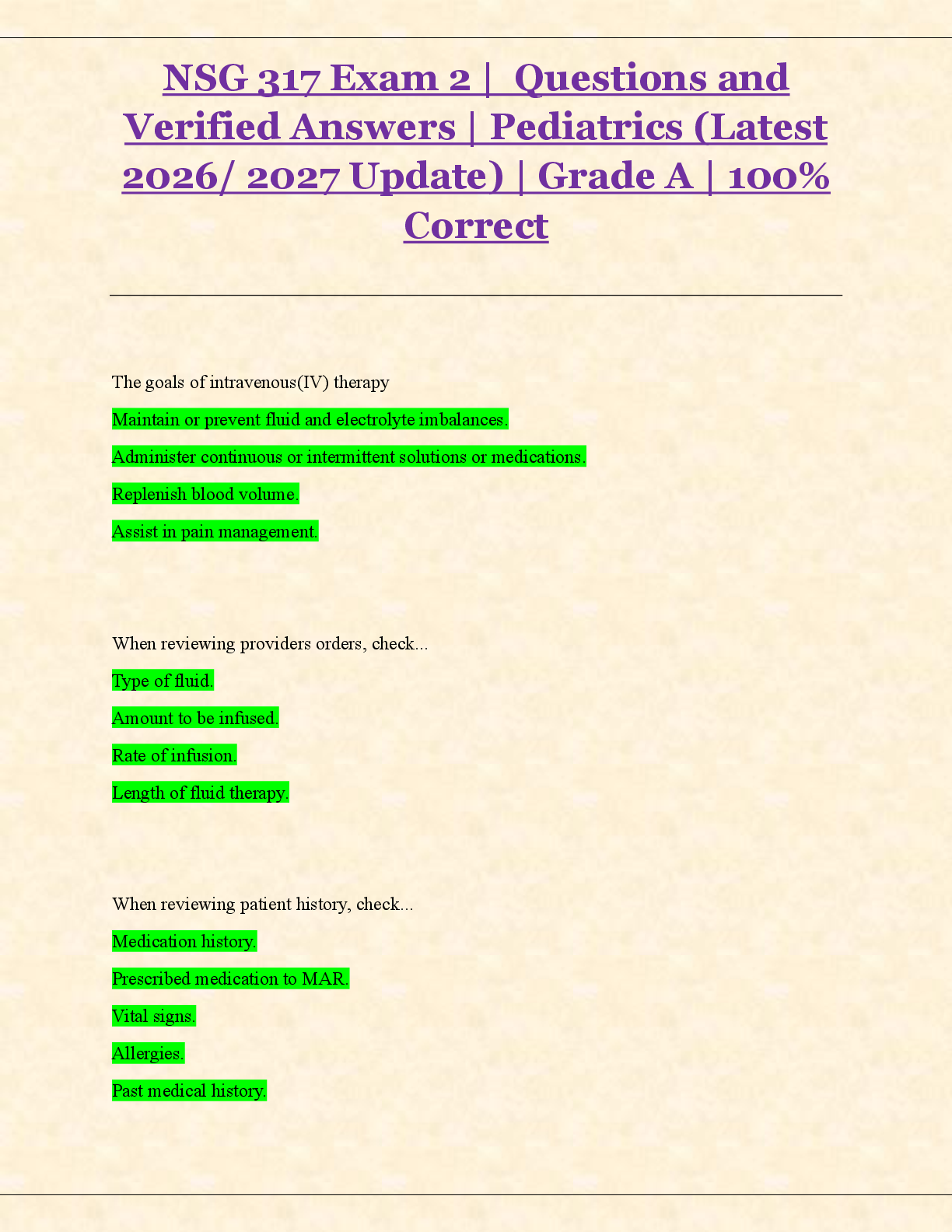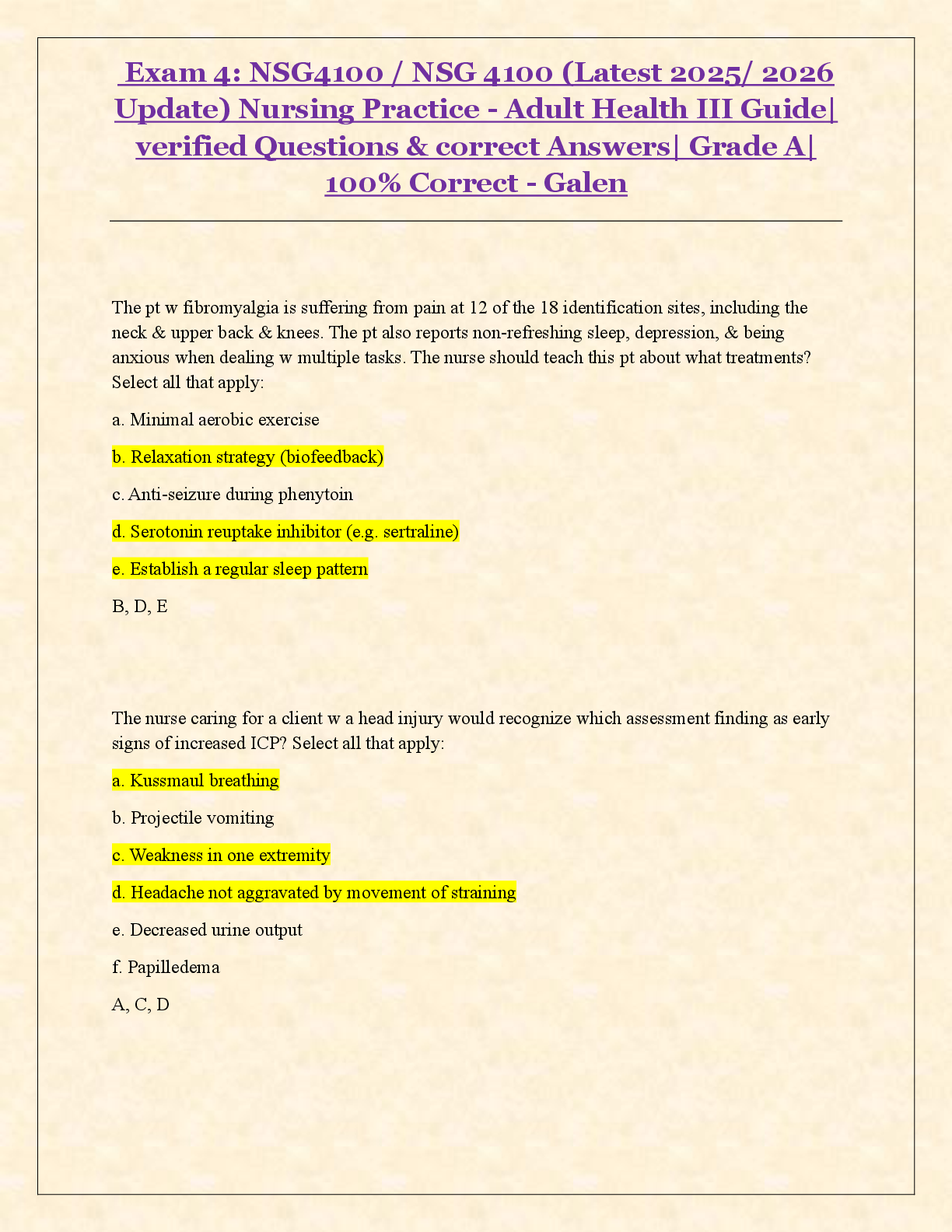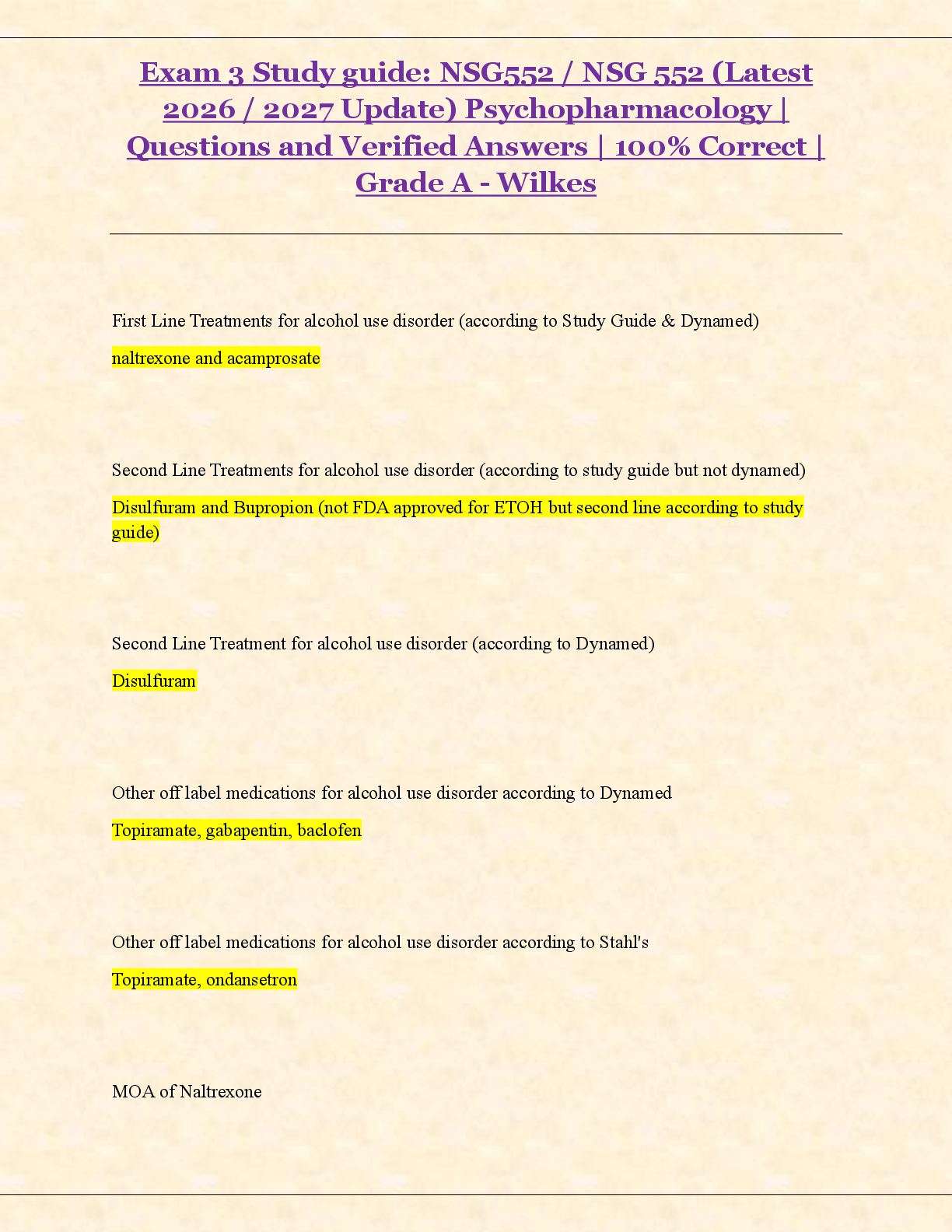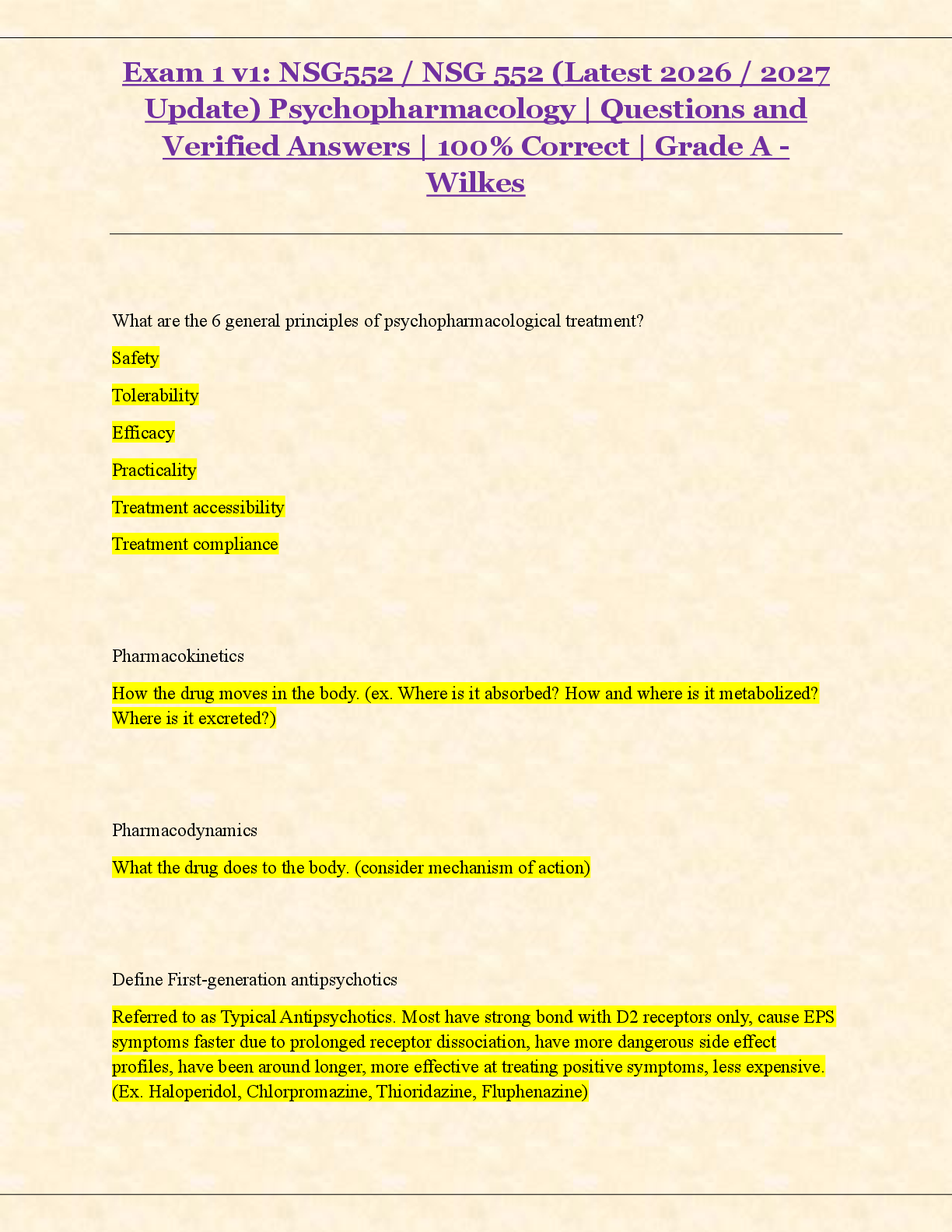N100 Final Study Guide
Document Content and Description Below
N100 Final Study Guide Hand-washing Infection · Stages of infection 1. . · Reporting Communicable Diseases Oxygenation ● Assessment ○ . ● Lungs Low Flow Oxygen Delivery Sy ... stems High Flow Oxygen Delivery Systems Mobility and Immobility Body mechanics- Factors affecting mobility Application of heat and cold: Therapeutic effects Heat Cold Types of heat application MOIST DRY Types of cold application DRY MOIST COMPLICATIONS Thrombophlebitis, Deep vein thrombosis Pulmonary embolism- Valsalva maneuver Raynaud’s phenomenon Hypervolemia Hypovolemia Fluid Deficit · Decrease blood volume · DEHYDRATION Post Mortem Care Vital Signs ● : ● Pulse ● Respirations: ● Temperature: ● Pain ○ P= Provoked; what caused it? What triggered it? ○ Q= Quality; Description of pain ○ R= Region/ Radiating; Where is it? Is it moving? ○ S= Severity; 0-10 pain scale ○ T= Time; When did it start? How often? Anything that make is better or worse? Wound Stages / Care ● Wound Dehiscence ○ Partial of total rupture (separation) of a sutured wound, usually with separation of underlying skin layers ● Wound Evisceration ○ A dehiscence that involves the protrusion of visceral organs through a wound opening Stages of Pressure Ulcers, Nursing Interventions to prevent pressure sores, Braden Scale SUSPECTED DEEP TISSUE INJURY, DEPTH UNKNOWN ● Discoloration but intact skin from damage to underlying tissue Stage 1: NON-BLANCHABLE ERYTHEMA ● Skin intact, non-blanchable redness, usually over a bony prominence; can feel warmer or cooler than adjacent tissue Stage 2: PARTIAL THICKNESS ● Involves epidermis and dermis; ulcer is reddish-pinkish bed w/o slough or bruising; is superficial; ap pear as an abrasion, blister, or shallow crater Stage 3: FULL THICKNESS SKIN LOSS ● Damage to or necrosis of SUBCUTANEOUS TISSUE; Fatty tissue visible Stage 4: FULL THICKNESS TISSUE LOSS ● o Damage to muscle, bone, sup porting structures; Nursing Interventions to prevent sores Avoid skin trauma ● Keep skin clean, dry intact ● Reposition patient every 2 hours, and every 1 hour if patient is in chair ● Keep head of bed at or below 30 degree angle (or flat) unless contraindicated to relieve pressure on sacrum, buttocks, and heels ● Raise heels off bed to prevent pressure ● Ambulate patients as much as possible ● Keep patients from sliding down bed Provide supportive devices Maintain Skin Hygiene ● Inspect skin frequently; document patients at risk using Braden Scale ● Clean skin with a mild cleansing agent, pat dry after urine or stool incontinence ● Do not bathe with hot water and avoid scrubbing ● Apply dimethiconeàmoisture for patient’s skin who has incontinence (uncontrolled peeing & pooping) Encourage proper nutrition ● Provide adequate hydration 2,000 to 3,000 mL/day; meet protein and calorie needs ● Note if serum albumin levels are low (< 3.5 g/dL) ● Lack of protein = patient at risk for skin breakdown ● Nutritional support Vitamin A, C; mineral supplements zinc, copper ● Monitor lymphocyte count ● Lift rather than pull, patients up in bed or in a chair, due to friction that can damage the outer layer of skin (epidermis) Braden Scale ● Used to assess patients who are at risk for pressure sores. ● Total score of 12 or less indicated high risk for pressure sores. Infiltration (extravasation) ● Pallor, local swelling at the site, cool to touch, damp dressing, slowed rate of infusion ○ Treatment ■ Stop infusion and remove catheter ■ Elevate the extremity ■ Encourage active ROM ■ Apply warm/cold compression depending on infused solution Phlebitis (thrombophlebitis) ● Edema, throbbing, burning, or pain at the site, increased skin temp; erythema; red lines up the arm with palpable band @ vien site, slowed rate of infusion ○ Treatment ■ Promptly DC the infusion and remove the catheter ■ Elevate ■ Apply warm compression 3-4 times/day ■ Restart infusion in different site Grief/Loss Grief - emotional response Mourning - expression Bereavement - both grief and mourning Advanced directives - legal documents that direct end-of-life issues ● Living will: Directive documents for medical treatment per the client’s wishes ● Health care proxy (aka durable power of attorney): appoints someone to make medical decisions when client is no longer able to do so on his own behalf Types of Loss ● Necessary loss: part of the cycle of life. Loss can be replaced by something different or better. ● Actual loss: Any loss of a valued person, item, or status, such as loss of a job that can be recognized by others ● Perceived loss: not obvious or verifiable to others ● Maturational or developmental loss: normally expected due to the developmental processing of life. These losses are associated with normal life transitions and help to develop coping skills (e.g., child leaving home for college). ● Situational loss: Any unanticipated loss caused by an external event (e.g., family loses home during tornado) ● Anticipatory loss: Experienced before the loss happens KÜBLER -ROSS MODEL ● Denial: The client has difficulty believing a terminal diagnosis or loss. ● Anger: The client lashes out at other people or things. ● Bargaining: The client negotiates for more time or a cure. ● Depression: The client is overwhelmingly saddened by the inability to change the situation. ● Acceptance: The client acknowledges what is happening and plans for the future by moving forward. (Stages might not be experienced in order, and the length of each stage varies from person to person) FACTORS INFLUENCING LOSS, GRIEF ● Individual’s current stage of development ● Gender ● Interpersonal relationships and social support networks ● Type and significance of the loss ● Culture and ethnicity ● Spiritual and religious beliefs and practices ● Prior experience with loss ● Socioeconomic status Grief Reactions ● Normal grief ○ Some acceptance should be evident by 6 months after the loss. ● Anticipatory grief ○ Implies the “letting go” of an object or person before the loss, as in a terminal illness ○ Start the grieving process before the actual loss ● Complicated grief ○ Unresolved or chronic grief is a type of complicated grief ○ The client can develop suicidal ideation, intense feelings of guilt, and lowered self-esteem ● Disenfranchised grief ○ This grief entails an experienced loss that cannot be publicly shared or is not socially acceptable, such as suicide and abortion Palliative care ● Nurse serves as an advocate for the client’s sense of dignity and self-esteem by providing palliative care at the end of life ● Improves the quality of life of clients and their families ● Interventions are primarily used when caring for clients who are dying and family members who are grieving ● Focus on the relief of physical manifestations (such as pain) as well as addressing spiritual, emotional, and psychosocial aspects of the client’s life Hospice care ● Is a comprehensive care delivery system ● Implemented when a client is not expected to live longer than 6 months ● Further medical care aimed toward a cure is stopped ● Focus becomes enhancing quality of life and supporting the client toward a peaceful and dignified death Postmortem care- Provide respect and compassion while attending to the desires of the family per cultural, religious, and social practices MD must call the code→ code blue o Maintain privacy o Remove all tubing if the pt has passed o Remove all personal belongings to give to family o Clean the patient o Clean the room-spoiled sheets and the gown o Dim the lights and minimize noise to provide a calm environment Rigor mortis sets in within 24 hrs- Use rigor mortis kit o Body bag o 3 tags - One for toe with pt ID -One for the bag - One for the belongings bag o Use the string under the chin and tie it around the head to keep jaw closed o Send to morgue NDE (near death experiences) o See a tunnel/ light o See other family who have passed o Above bodies watching what’s happening Body before death - Paleness, dusky, grey, ashy - Puzzled skin (modeling) - Depressed respirations - Labored breathing - Cheyenne stokes- hyperventilation and then they have moments of APNEA Physical Assessment · Head to toe · Assessing systems -Purpose: to make a plan of care o Level of consciousness- neurological status · Person- know who they are? · Place- know where they are? · Time- know date it is? · Situation- current event? Know who prez. Is? · Got two questions write: LOCx2 o PUPILS · w/ pen light check pupils for reactivity · PERRLA ❖ Pupils- size ❖ Equal ❖ Round ❖ Reactive- sluggish, brisk, nonreactive ❖ Light ❖ Accommodation- eyes going up down and over each side ❖ Cranial nerves- 3,4, 6→ pupils reactivity/ ocular movement ➢ Cranial nerve: 2-→ vision o Check Ears, Nose, Mouth · Drainage? Blood? Deviation? o Face · Symmetry of facial features, expression · No involuntary movement · Proportionate · Stroke: face drooped, slurred speech o Posture · Decorticate: damage to one o more corticospinal tracts · Decerebrate: damage to upper brain stem · Different posture depend on damaged spinal cord o Lungs · Ask: any problem breathing? · Is the chest symmetrical? Lopsided? Watch respirations in and out · Anterior: 6 areas · Posterior: 8 areas · Listening for wheezing (high pitched, musical sound, inspiratory? excretory?), crackles/ rales (rice crispys), strider bronchi (low pitched, snoring sound), anything abnormal -Diminished breath sounds→ adolectasy ❖ Where are you hearing it? Right/ left/ anterior/ posterior/ upper/ lower/ bilaterally · LISTEN ON YOUTUBE!! IDENTIFY!! o Heart · Ask: having any chest pain? - All People Enjoy Time Magazine · Second intercostal space right, listen to aortic valve · Second intercostal space left, Pulmonic valve · Third intercostal space on left side, erb's point · Fourth intercostal space left, tricuspid valve · Fourth/ fifth intercostal space left, mitral valve ➢ Listening for LUB DUB · S1: closing of tricuspid/ mitral valve · S2: closing of aortic/ pulmonic valve o Abdomen · S3: ventricular gallop, Ken-tu-cky ❖ See it in pregnant women,kids, hypertension, and CHF · S4: Ten-ne-ssee ❖ Murmurs · Ask: when was your last bowel movement? · LOOK LISTEN FEEL · Into 4 quads RU, RL, LL, LU o Inspect · Is it extended? Trauma? Scar? Dressing? Colostomy bag? Movement? o Osculate · Listen for bowel sounds ■ Assess patient first then tell physician ● Discrepancy w/ medication→ call physician ● If medication falls to ground, put it in medication waste container ● Proper safeguarding and storage of medications ● Obtain info about client and conditions that relate to med administration ○ Identify allergies ○ Obtain HR and BP to assess before administering for appropriateness ● Question provider is prescription unclear or seems inappropriate for patient ○ Refuse to administer if it seems unsafe ● Prepare medications one client at a time ● Check labels, read carefully, measure accurately ● If label cannot be read, send back to pharmacist ○ If no label, throw it away ● Keep medications in secure area ● Must have witness when discarding medications (narcotics) ● Document time administering patient-- 1 hr. Window Medication Right 1. Patient ● name & dob 2. Medication ● generic/ brand name- know right one ● Any medication not labeled properly- discard it ● Check expiration date 3. Dose ● check medication 3 times- before, during, before administration ■ Looking @ order ■ Check when receiving medication ■ Check by bedside before giving medication ● Scored tablet- precut already to cut easier 4. Route ● oral ● interal- going through digestive system ● sublingual- under the tongue ● buccal- side of cheek ● parenteral- IV, im, subq-fatty tissue 5. Time ● Onset of medication, how quick it begins to work: ■ IV: 2-5 min ■ PO 30-45 min ■ Subq 3-20 min ■ "stat" within 15 min ■ "now" up to 90 min 6. Refuse ● If patient refuses ask patient why they don’t want the medication ■ Makes them feel nauseous? Dizzy? Talk with provider to change medication ■ Explain the importance of the medication ● Discard medication and document it 7. Documentation ● Client's response to medication Respiratory Alkalosis/ Acidosis, Metabolic Alkalosis/ Acidosis Normal arterial blood gas values: ● pH= 7.35-7.45 ● Co2= 35-45 ● HCO3= 22-28 Use ROME ● R,O= Respiratory, Opposite ● M, E= Metabolic, Equal Respiratory Acidosis ● pH= decreased <7.35 ● CO2= increased >45 ● HCO3= normal range Causes of Respiratory Acidosis: ● Oversedation ● Obstructive lung disease ● Head injuries ● Cardiac arrest ● Congestive heart failure Respiratory Alkalosis ● pH= increased > 7.45 ● Co2= decreased < 35 ● HCo3= normal range Causes of Respiratory Alkalosis: ● Hyperventilation ● Pulmonary Embolus ● Mechanical ventilation ● Salicylate intoxication Metabolic Acidosis: ● pH= decreased <7.35 ● Co2= normal ranges ● HCO3= decreased <22 Causes of Metabolic Acidosis: ● Diarrhea ● Diabetic Ketoacidosis ● Starvation ketosis ● Poisonings ● Renal Failure Metabolic Alkalosis ● pH= increased >7.45 ● Co2= normal range ● Hco3= increased >28 Causes of metabolic alkalosis ● Vomiting ● NG suction ● Diuretic therapy ● Corticosteroid therapy ● Cushing’s disease ● Excessive antacids Spirituality/ Religion Spirituality vs Religion ➔ Religion is set if beliefs, more organized, institutionalized, express one's spirituality ◆ Spiritual distress can be due to catastrophic events where patient displays hopelessness and decreased interaction with others ◆ Begin to question their belief and unable to find support from belief system ◆ Nursing interventions include: reconnecting and restoring to spiritual strength ◆ ➔ Spirituality is individual, internal, own beliefs, awareness of one's own greater purpose ◆ Intrapersonal: within one’s self ◆ Interpersonal: with others and the environment ◆ Transpersonal: with an unseen higher power Faith- belief of higher power Hope- anticipation and optimism and comfort during crisis Religion- system of beliefs practiced outwardly to express one’s spirituality Buddhism ● Refuse care on holy days ● Refuse strong sedatives ● Some vegetarians ● Avoid alcohol/ tobacco § Exercise regularly § Eat small meals that are high in protein § Avoid activities that increase sleepiness · Ex.) sitting too long, warm environments, drinking alcohol § Avoid activities that could cause injury · Ex.) driving § Take naps when drowsy or when attacks normally happen § Take prescribed stimulants. Factors that affect sleep · Illness · Current life events · Emotional stress/Mental status · Diet · Exercise · Fatigue · Sleep environment · Medications Patient Safety · After an incident, assess patient first before anything else · If patient is ambulating and they start to have shortness of breath, have them sit down first. O If they are laying down = raise head of bed first Preventing falls: · Place patient with high risk, closest to nurses station. · Position the bed at the lowest position and locked · Color-coded wrist band (fall-risk alert) = yellow · Side rails up · Make sure the room is well lit · Place patient’s belongings and call light within reach · Use a bed alarm · Provide nonskid footwear and bath mats · Hourly rounding · Use gait belts and assistive equipment when moving a patient · Keep the floor clean , dry and free of clutter · Educate the client and family about safety risks Fall Risks · Surgery · Malnutrition · Old age · Orthostatic hypertension (when they stand up their blood pressure drops) · Medicated Patients (Meds make them sleepy/dizzy) · Decreased visual acuity · Generalized weakness · Urinary frequency · Gait/balance problems Seizure = a sudden surge of electrical activity in the brain. · Partial = electrical surges in one part of the brain. · Generalized = involves the entire brain. · Status Epilepticus = prolonged seizure (medical emergency) Seizure Precautions · Make sure equipment is at bedside o Oxygen, an oral airway, suction equipment, and padding for the rails. o For pts with history of seizures, have a saline lock in place. o Make sure environment is safe. o Assist with ambulation and transferring o Do not put anything in their mouth o Do not restrain patient during seizure During Seizure · Stay with the client and call for help · Maintain airway patency and suction PRN · Administer meds · Note the duration and the sequence After Seizure · Determine the mental status · Take vitals Seclusion and Restraint · Obtain doctors order/signature within 24 hours o Must include: § Reason § Type of restraints § Location of the restraints § Duration of use § Type of behavior that warrants the use of restraints o Will only allow § Adult = 4 hours § Ages 9 – 17 = 2 hours § Age < 9 = 1 hour § PRN is not allowed · Use quick release tie · Check restraints every 2 hours · 2 fingers worth of room · Consent form from client or guardian · Never leave the client alone with restraints · Inappropriate use includes: o Convenience of the staff. o Punishment for the client. o Clients who are extremely physical or mentally unstable. o Clients who cannot tolerate the decreased stimulation of a seclusion room. Fire Response · Most common causes: o Electrical, anesthetic equipment, smoking. · RACE o R = Rescue § Clients who are closest to the fire o A = Alarm § Activate the hospital fire alarm and report location o C = Contain/Confine § Close doors and windows § Turn off O2 and other electrical devices § Clients with life support, ventilate with bag-valve mask o E = Extinguish § Fire Extinguishers: · PASS o P = pull the pin o A = aim at the bass of the fire o S = squeeze the handle o S = sweep the extinguisher side to side · Class: o Class A = combustibles § Paper, wood, upholstery, rags, trash fires, etc… o Class B = Flammable liquids/Gas fires o Class C = electrical fires Types of Medications, Ap plication and Side Effects 1. Anti- inflammatory - Aspirin, Motrin, Naproxen, Celebrex Side effects: Heartburn, Nausea, Upset Stomach, GI bleeds 2. Laxative/ Fiber: Bisacodyl Colace - Stool softner Dulcolax: stimulates movement Senna Senokot Metamucil: Fiber additive Side effects: Diarrhea, abdominal cramping, discomfort 3. Pain Medication (opioids): Vicodin, Oxycontin, Norco, Morphine, Fentanyl, Percocet, Dilaudid, Tramadol, Motrin Side Effects: Drowsiness, Dry Mouth, Constipation, Respiratory Depression 4. Sedative, Sleep, Aids, Anti anxiety: Ambien: Sedative Ativan: Sedative, Sleep Aid, Anti anxiety Buspar: Sleep Aid Restoril Midazolam: Sedative Valium Xanax: Anti anxiety Culture Race = Biological attributes Ethnicity = the shared identity, bond or kinship people feel with their country of birth or place of ancestral origin. Culture = collection of learned, adaptive and socially and intergenerationally transmitted behaviors, beliefs and customs that form the context from which a group interprets the human experience. Culture includes: o Language o Communication style o Traditions, religions o Art o Music o Dress o Health beliefs o Health practices Culture competency ● Understand and address the entire cultural context of each client ● Enables the healthcare provider to deliver services needed ● Goal is to provide cultural competent care Cultural congruent care ● Care that falls within the type of belief the individual you are caring for. ● Life patterns, values, and systems of meaning ● Providing that care that fits their lifestyle patterns Cultural Awareness ● Being aware of other individuals/ Pts culture Culturally Sensitive ● Knowledgeable about the cultures prevalent in their area of practice. Culturally Appropriate ● Applying knowledge of pt’s culture to their care delivery Culturally Responsive ● Improves communication, fosters mutual respect, promotes sensitive and effective care and increases adherence with the treatment plan to fit pt’s needs. ● Should encourage client decision-making with self-empowerment strategies. Cultural Imposition ● Understanding and awareness of their own culture and any cultural biases that may affect care delivery. Barriers: ● Language/Communication ○ Always get an interpreter ● Culturally inappropriate tests and tools that lead to misdiagnosis ● Ethnic variations in drug metabolism ● Ethnocentrism = the belief that one’s culture is superior to others. Stress/Coping Adherence = the commitment and ability of the client and family to follow a given treatment regime. ● Denial is non-adherence Stress = changes in an individual’s state of balance in response to stressors (internal/external) ● Common causes: ○ Situational ○ Developmental ○ Sociocultural ● Interventions ○ Health promotion ■ Exercise ■ Optimal nutrition ■ Adequate sleep/rest ○ Time management ○ Relaxation techniques ■ Breathing exercises ■ Manage ■ Imagery ■ Yoga ■ Meditation ○ Listen attentively ○ Reduce external stressors ○ Support systems ○ Available resources ● Stress can alter function Roles ● Function a person adopts within their life. ○ Ex.) Grandparent, Parent, Dependent child, Employee/employer, Committee member, Community activists. ● Role problems: ○ Role conflict = opposing roles ■ Interpersonal (parents expecting child to play sports) ■ Inter-role (mother wants to stay home with baby but she must work) ○ Sick role = Expectations of others and society on how someone should behave when sick. (caring for self while sick/continue caring for grandchildren) ○ Role strain = uncertainty about what is expected when assuming a role; creates confusion ○ Role overload = more responsibility and roles than manageable ● Situational role changes ○ Situations other than physical growth and development ○ Temporary = pt will resume after illness ○ Permanent = altered level of the client’s health; previous roles are no longer available Abbreviations Conversions 1 gr= 60 or 65 mg (gr stands for grain, Do not confuse with gram, gr, or gm) 1,000 micrograms (mcg)= 1 milligram (mg) 1,000 grams (g or gm)=1 kilogram (kg) 2.2 pounds (lbs) = 1 kilogram (kg) 30 milliliters (mL)= 1 liter (L) 3 teaspoons (tsp) = 1 tablespoon (tbsp) 1 tablespoon (tbsp) = 15 milliliters (mL) 1 teaspoon (tsp)= 5 milliliters (mL) 1 cup= 8 oz 1 oz= 30 ml Hospice/Palliative Care Palliative care ● Improves the quality of life of clients and their families facing end of life issues ● Focuses on the relief of physical manifestations such as pain as well as addressing spiritual, emotional, and psychosocial ● Provided by an interprofessional team of physicians, nurses, social workers, physical therapists, massage therapists, occupational therapists ● Nurse serves as an advocate for end of care life Hospice care ● Comprehensive care delivery system performed in a variety of settings ● Patient not expected to live longer than 6 months ● Further medical care is stopped ● Focuses on enhancing quality of life and supporting the client toward a peaceful and dignified health PTSD: Post traumatic stress is a psychiatric disorder characterized by an acute emotional response to a traumatic event or situation. -→ Exposure to a traumatic event that causes intense fear, horror, flash-backs, feelings of detachment, restricted affect and impairment for longer than 1 month after the event. Symptoms can last for years. Language Barrier: When a patient is unable to communicate due to a hearing impairment or language barrier, a trained medical interpreter must be used. A family member does not suffice as an appropriate interpreter. Nutrition ● Provide energy for… ○ Cellular metabolism ○ Tissue maintenance and repair ○ Organ function ○ Growth and development ○ Physical activity ● Basic nutrients the body requires ○ Carbohydrates ■ Provides most of the body’s energy and fiber ■ Eac gram produces 4 kcal ■ Provides glucose ■ Types of carbohydrates ● Whole grain breads ● Baked potatoes ● Brown rice ○ Fats ■ Provides energy and vitamins ■ No more than 35% of caloric intake should be from fat. ■ Each gram produces 9 kcal ■ Types of fats ● Olive oil ● Salmon ● Egg yolks ○ Proteins ■ Contributes to the… ● Growth ● Maintenance ● Repair of body tissue ■ Each gram produces 4kcal ■ Types of Proteins ● Beef ● Whole milk ● Poultry ○ Vitamins ■ Necessary for metabolism ■ Fat-Soluble vitamins ● A, D, E, K ■ Water-soluble vitamins ● C and B Complex (eight vitamins) ○ Minerals ■ Essential biochemical reactions in the body ■ Types of minerals ● Calcium ● Potassium ● Sodium ● Iron ○ Water ■ Critical for cell function ■ Replaces fluids the body loses through ● Perspiration ● Elimination ● Respiration ● Factors affecting nutrition and metabolism ○ Religious and cultural practices ■ Guide food preparation and choices ○ Financial issues ■ Prevents some clients from buying foods that are high in protein, vitamins and minerals ○ Appetite ■ Decreases with… ● Illness ● Medications ● Pain ● Depression ● Unpleasant environmental stimuli ○ Negative experiences ■ Clients like help determine preferences with certain foods or familiarity with foods ○ Environmental factors ■ Sedentary lifestyles ■ Work schedules ■ Widespread access to less healthy foods contribute to obesity ○ Disease and illness ■ Can affect the functional ability to prepare and eat food ○ Medications ■ Can alter taste and appetite ■ Can interfere with the absorption of certain nutrients ○ Age ■ Affects nutritional requirements ● Age related to Nutrition ○ Adolescents (12 to 20 years) ■ Metabolic demands are high and require more energy ■ Protein, calcium, iron, iodine, folic acid and vitamin B needs are high ■ One-fourth if dietary intake comes from snacks ■ Increased water consumption is important for active adolescents ■ Things that influence adolescents’ diet ● Body image and appearance ● Fast foods ● Peer pressure ● Fat diets ○ Young adults (20-35 years) and Middle adults (35 to 65 years) ■ Decreased need for most nutrients (except during pregnancy) ■ Calcium and iron are essential minerals for women ■ Good oral health is important ○ Older adults (over 65 years) ■ Slower metabolic rate requires fewer calories ■ Thirst sensations diminish ■ Need the same amount of most vitamins and minerals as younger adults ■ Calcium is important for both men and women ■ Require carbohydrates that provide fiber and bulk to enhance gastrointestinal function. ● Eating disorders ○ Anorexia Nervosa ■ Low body weight for… ● Gender ● Age ● Developmental level ● Physical health ■ Fear of being fat ■ Consistent restriction of food intake ■ Repeated behavior that prevents weight gain ○ Bulimia nervosa ■ A cycle of binge eating followed by purging ● Vomiting, using diuretics or laxatives, exercise, fasting ■ Lack of control during binges ■ At least one cycle of binge eating and purging per week for at least 3 months ○ Binge-eating disorder ■ Repeated episodes of binge eating ● Feels a loss of control when binge eating ● Feels emotional response such as guilt, shame, or depression ● Does not use compensatory behaviors such as purging ● Episodes can range from 1 to more than 14 times pers week ● Clients are often overweight or obese ● Therapeutic diets ○ Clear liquid ■ Little residue ● Clear fruit juices ● Gelatin ● Broth ○ Full liquid ■ Clear liquids ■ Liquid dairy producs ■ Juices ■ Pureed vegetables ○ Pureed ■ Clear and full liquids ■ Pureed meats ■ Fruits ■ Scrambled eggs ○ Mechanical soft ■ Clear and full liquids ■ Diced or ground foods ○ Soft/low-residue ■ Foods low in fiber and easy to digest ○ High-fiber ■ Whole grains, raw and dried fruits ○ Low sodium ■ No added salt or 1 to 2 g sodium ○ Low cholesterol ■ No more than 300mg/day of dietary cholesterol ○ Diabetic ■ Balanced intake of protein, fats, and carbohydrates of about 1,800 calories ○ Dysphagia ■ Pureed food and thickened liquids ○ Regular ■ No restrictions Bowel Elimination ● Check stool for culture, parasites, ova, and worms Fecal occult blood testing (guaiac test) ● Asepsis glove fecal sample ● Collect stool sample 3 times from 3 different defecations ● Some foods red meat, fish, poultry, raw vegetables, and medications can cause false positive results ● Bleeding can be an indication of cancer Colostomy ● End in the colon Ileostomies ● End in the ileum End stomas ● Result of colorectal cancer or some types of bowel disease Loop colostomies ● Temporary and helps resolves medical emergencies ● Loop bowel supported on the abdomen with a proximal stoma draining stool and a distal stoma draining mucus. ● Constructed in the transverse colon Double barrel colostomies ● 2 abdominal stomas one proximal one distal ● Proximal drains stool and distal stoma leads to inactive intestine ● After intestines heals colostomy is reversed by reattaching the two ends Lab Values 1. Magnesium (Mg) : 1.5 - 2.5 2. Calcium (Ca): 8.6- 10 mg/dL 3. Chloride (Cl-): 99-109 4. Glucose: 74-105 mg/dL 5. Potassium (K+): 3.5-5.5 6. Sodium (Na+): 135-145 mEq/L 7. BUN: 9-23 8. Creatinine (F): 0.5-1.1 mg/dl (M): 0.7-1.3 mg/dl 9. Protein: 6.4-8.3 g/L 10. Albumin: 3.2 4.8 g/L Therapeutic Communication ● Foundation to nurse-client relationship ● Use of communication to build and maintain relationships with clients & their families. ● Nurses use therapeutic communication to: ○ Care for client’s thoughts, feelings, concerns, needs ○ Express empathy and concern ○ Obtain information to give feedback about client’s status ○ Promote functional behavior and interpersonal relationships ○ Evaluate client’s progress toward goals and outcomes ● Techniques vary depending on age group of client ● Essential components of therapeutic communication: ○ Time: Allow time to communicate. ○ Attentive behavior or active listening: Convey interest, trust and acceptance. ○ Caring attitude: Show concern and create an emotional connection and support system. ○ Honesty: Be open, direct, truthful, and sincere. ○ Trust: Demonstrate reliability. ○ Empathy: Show awareness and understanding of feelings & emotions. ○ Nonjudgmental attitude: A display of acceptance of clients, families and encourage open, honest communication. Urinary Elimination ● Bladder collects approx. 150-200 mL urine before elimination. ● Adults produce approx. 1,500-2,000 mL/day of urine. ● Factors affecting urinary elimination: ○ Age ■ Older adults ● Lose muscle tone of bladder → increase in frequency ● Inefficient emptying of bladder, leaving residual urine → increase in risk for UTI ● Increase in nocturia ○ Pregnancy ■ Bladder space compromised by growing fetus → compression of bladder ○ Diet ■ Increase in sodium → decreased urination ■ Caffeine & alcohol → increased urination ○ Immobility ○ Psychosocial factors ■ Emotional stress and anxiety ■ Lack of privacy during hospital stays ■ Having to use public toilets ○ Pain ■ Suppression of urge to urinate when there is pain in urinary tract ■ Arthritis or painful joints cause immobility and lead to delayed urination. ○ Surgical procedures ■ Anesthesia → alteration in glomerular filtration rate → decreased urine output ○ Medications ■ Diuretics prevent reabsorption of water ■ Antihistamines and anticholinergics → urinary retention Urinary Tract Infections (UTI) ● Most due to E. Coli ● Risk factors: ○ In women, close proximity to urethral meatus to the anus ○ Frequent secual intercourse ○ Menopause: decreasing estrogen levels ○ Uncircumcised males ○ Use of indwelling catheters ● Nursing considerations: ○ Cleanse female clients from front to back, never back to front ○ Cleanse beneath the foreskin in males ○ Provide catheter care regularly Urinary Incontinence ● Significant contributing factor to skin breakdown and falls, especially in older adults. ● Major types of urinary incontinence: ○ Stress: Loss of small amounts of urine from increased abdominal pressure (laughing, sneezing, lifting, etc.) ○ Urge: Inability to stop urine flow long enough to reach bathroom due to overactive detrusor muscle with increased bladder pressure. ○ Overflow: Urinary retention and frequent loss of small amounts of urine due to obstruction of urinary outlet or impaired detrusor muscle. ○ Reflex: Involuntary loss of moderate amount of urine usually without warning due to hyperreflexia of detrusor muscle, usually from spinal cord dysfunction. ○ Functional: Loss of urine due to factors that interfere with responding to the need to urinate (such as cognitive, mobility, and environmental barriers). ○ Total: Unpredictable, involuntary loss of urine that generally does not respond to treatment. NANDA (Implementation of Nursing Diagnosis) ● ADPIE ○ Assess ■ Collection of subjective/objective data ○ Diagnosis ■ Analyzing that data ○ Planning ■ Create goals ○ Implementation ■ Putting goals into action ○ Evaluate ■ Try to determine effectiveness of these goals Therapeutic Communication: to help build and maintain relationships with clients, families, and significant others Basic Communication: ● Intrapersonal communication- communication with self. ● Interpersonal communication- communication between two people. ● Public communication- talking to a group of people. ● Transpersonal communication- communication that addresses spiritual needs (praying, meditation). ● Small group communication- communication within a group of people, often working toward a mutual goal (committees, research teams, support groups). Verbal Communication: ● Use vocabulary the patient understands. (simple, straightforward language for children) ● Know when to communicate and be aware of the pace you are communicating (rapid speech suggest you don't have time for patient). ● Be aware of tone of voice. Nonverbal Communication: ● Appearance, posture, gait- body language can demonstrate comfort and ease. ● Facial Expressions, eye contact, gestures- facial expressions can easily be misinterpreted. Eye contact conveys interest. Gestures can enhance verbal communication or create their own messages. ● Sounds- crying and moaning can have multiple meanings. ● Territorial, personal space- lack of awareness of territoriality and personal space can make clients feel threatened and can cause them to act defensively. Essential Components: ● Time- plan for and allow time to communicate with others. ● Attentive behavior or active listening- conveys interest, trust and acceptance. ● Caring attitude- show concern and emotional connection. Support other nurses, clients, families. ● Honesty- be open, direct, truthful and sincere. ● Trust- demonstrate to. clients, families and significant others that they can rely on nurses. ● Empathy- convey an objective awareness and understanding of the feelings, emotions, and behavior of client, families, significant other. ● Nonjudgemental attitude- a display of acceptance of client. Assessment ● Determine verbal and nonverbal communication needs for patient ● Make sure assistive devices (glasses, hearing aids) are available for patients who need them ● Minimize distractions, speak in short simple sentences and allow time for older adult patients to respond Skills and Techniques ● Silence- allows time for patient to self-reflect ● Open-ended questions- encourages the patient to explore feelings and thoughts and avoids yes or no answers ● Restating- uses the patient’s exact words to help clarify the patient’s message ● Reflecting- directs focus back to the patient to examine his/her feelings ● Paraphrasing- restates the patient’s thoughts to confirm what he/she has communicated ● Exploring- allows the nurse to gather more information about the patient S-ituation (present, what’s going on at the moment) B-ackground (past, history) A-ssessment (what you assessed, ex. lungs clear) R-ecommendation (future, ex. Consults) NANDA ● Problem-focused nursing diagnoses [Problem, diagnostic label] related to [etiology, contributing factors] as evidenced by [signs and symptoms] ● In two-part and three-part diagnostic statements, related to reflects a relationship between the first and second parts of the statement. UTI’s and Incontinence ● Most urinary tract infections are due to E. Coli ● Risk factors: woman, frequent intercourse, menopause (decreased estrogen levels), uncircumcised males, use of indwelling catheters ● Nursing Considerations: Cleanse females from front to back, cleanse beneath the foreskin in males, provide catheter care regularly, drink cranberry juice, increase fluid intake (2500-3000 cc’s) ● Therapeutic Procedures: -Bladder-retraining program- clients should urinate at scheduled times; clients should gradually increase urination intervals after no incontinence episodes for 3 days, working toward the optimal 4 hour intervals; remind clients to hold urine until the scheduled toiling time; encourage client to keep track of urination times -Urinary habit training- helps clients who have limited cognitive ability to establish a predictable pattern of bladder emptying -Intermittent urinary catheterization- periodic catheterization to empty the bladder. It reduces the risk of infection from indwelling catheterization. ● Urinary Incontinence: -Stress- loss of small amounts of urine from laughing, sneezing or lifting -Urge- inability to stop urine flow long enough to reach the bathroom due to an overactive detrusor muscle with increase bladder pressure -Overflow- urinary retention from bladder overdistension and frequent loss of small amounts of urine due to obstruction of the urinary outlet or an impaired detrusor muscle -Reflex- involuntary loss of moderate amount of urine usually without warning due to hyperreflexia of the detrusor muscle -Functional- loss of urine due to factors that interfere with responding to the need to urinate, such as cognitive, mobility, and environmental barriers -Total- unpredictable, involuntary loss of urine that generally does not respond to treatment ● Lab Tests: urinalysis (nonsterile) and urine culture sensitivity (sterile technique), serum creatinine and BUN to assess renal function (elevated with renal dysfunction) ● Nursing care: Establish toileting schedule, monitor I&O, provide incontinence garments, avoid use of indwelling catheters, teach patients keep an incontinence diary, Kegel exercises, bladder compression techniques, avoid caffeine and alcohol, adverse effects of medications that affect urine, vaginal cone therapy to strengthen pelvic muscles ● Medications: -Antibiotics (gentamicin and cephalexin) for infection. Antibiotics might change the urine’s odor. -Trycyclic antidepressants. Nortriptyline has anticholinergic effects that help relieve urinary incontinence -Urinary antispasmodics or anticholinergic agents (oxybutynin and dicyclomine) decrease urgency and help alleviate pain from a neurogenic or overactive bladder -Phenazopyrdine is a bladder analgesic that treats the symptoms of UTIs. This medication will not treat infection but will help relieve bladder discomfort. This medication turns urine orange. Stages of Death (Kubler-Ross Model) ● Denial: The client has difficulty believing a terminal diagnosis or loss ● Anger: The client lashes out at other people or things ● Bargaining: The client negotiates for more time or a cure ● Depression: The client is overwhelmingly saddened by the inability to change their situation ● Acceptance: The client acknowledges what is happening and plans for the future by moving forward. Stages might not be experienced in order, and the length of each stage varies from person to person. Coping (p.179) Coping- describes how an individual deals with problems , such as illness and stress. Factors involved in coping and adaptation include: ● Client’s family dynamics ● Adherence to treatment ● Role an individual can play in important relationships Stress- describes changes in an individual’s state of balance in response to stressors that disrupt the state of balance. Coping- describes how an individual deals with problems and issues Factors affecting an individual’s ability to cope include: ● Number, duration, and intensity of stressors ● Individual’s past experiences ● Current support system ● Available resources Adaptation- coping behavior that describes how an individual handles demands imposed by the environment. GENERAL ADAPTATION SYNDROME (GAS) ● Alarm reaction- body functions are heightened in response to stressors. ● Resistance stage- body functions normalize while responding to the stressor. ● Exhaustion stage- body functions are no longer able to maintain a response to the stressor and the client cannot adapt. Adherence- commitment and ability of the client and family to follow a given treatment regimen. Family system and dynamics Family- is defined by the client and it consists of the individual structures and roles. Family forms ● Nuclear family- consists of husband and wife (plus children) ● Extended family- includes relatives (aunts, uncles, grandparents, cousins) in addition to the nuclear family ● Single parent ● Blended family- formed when parents bring unrelated children from prior adoptive or foster parenting relationships into a new, joint, living, situation. ● Alternative family- relationships include multi-adult household, “skip generation” families (grandparents caring for their grandchildren) communal groups with children, “nonfamilies” (adults living alone), cohabitating partners, and homosexual couples. Sandwich generation- adults around 30-40 years old with young children of their own and have adults to take care of Attributes of family ● Structure dictates family’s ability to cope ○ Rigid structure- dictatorial and strict ○ Open structure- few or no boundaries, consistent behavior, or consequences ● Function describes the course of action the family uses to reach its goals. Role- function of a person adopts within their life Situational role changes - Caused by situations other than physical growth or development ● TEMPORARY ROLE CHANGES- client will resume the role when illness resolves ● PERMANENT ROLE CHANGES- illness has altered the level of the client’s health to a point that previous roles are no longer available. Role- function of a person adopts within their life Types of role problems ● Role conflict- develops when a person assume opposing roles with incompatible expectations ● Sick role- expectations of others and the society regarding how one should behave when sick. ● Role ambiguity- uncertainty about what is expected when assuming a role; creates confusion ● Role strain- the frustration and anxiety that occur when a person feels inadequate for assuming a role (caring for a parent dementia) ● Role overload- more responsibility and roles than are manageable. Nursing care ● Provide short term care to provide relief for the family caregiver ● Provide encouragement ● Evaluate the client for acceptance of the role changes to assess adaptation ● Refer client to social assistance ● Counsel the client about the roles permanently altered ● Help the client improve personal judgement of self-worth ● Anticipate role conflict or overload on the client’s part ● Help the client improve relationships by supplementing specific role behaviors Self concept and sexuality (p. 185) Self concept - the way individuals feel and view about themselves. - Is subjective and includes self identity, body image, role performance, and self esteem - Can be adversely affected by physical, spiritual, emotional, sexual, familial, and sociocultural stressors. - Nurses should suggest a healthier lifestyle, encourage the client to verbalize fears or anxieties, use therapeutic communication, and reinforce strengths and successes. Body image - Changes with growth and development - Refers to the ways individuals perceive their appearance, size, and body structure, - During adolescence, hormonal changes include the development of secondary sex characteristics - For older adults, changes include thinning and graying of hair, mobility, and decreased hearing and visual acuity. - Clients who have a negative body image perception tend to be at risk for SUICIDAL IDEATIONS Sexuality - Sexual health:occurs when relationships are safe, enjoyable and respected. - Use the PLISSIT assessment tool for sexuality ● P: permission (obtain permission to discuss with the client ● LI: Limited Information (related to sexual health patterns) ● SS: Specific suggestions (based upon data make appropriate suggestions) ● IT: intensive therapy (more referral as needed). - Some prescription meds affect sexual functioning ○ Diuretics decrease vaginal lubrication, cause erectile dysfunction, and reduce sexual desire, ○ Antidepressants can also cause erectile dysfunction. [Show More]
Last updated: 3 years ago
Preview 1 out of 83 pages
.png)
Buy this document to get the full access instantly
Instant Download Access after purchase
Buy NowInstant download
We Accept:

Reviews( 0 )
$13.00
Can't find what you want? Try our AI powered Search
Document information
Connected school, study & course
About the document
Uploaded On
Jul 31, 2021
Number of pages
83
Written in
All
Additional information
This document has been written for:
Uploaded
Jul 31, 2021
Downloads
0
Views
100







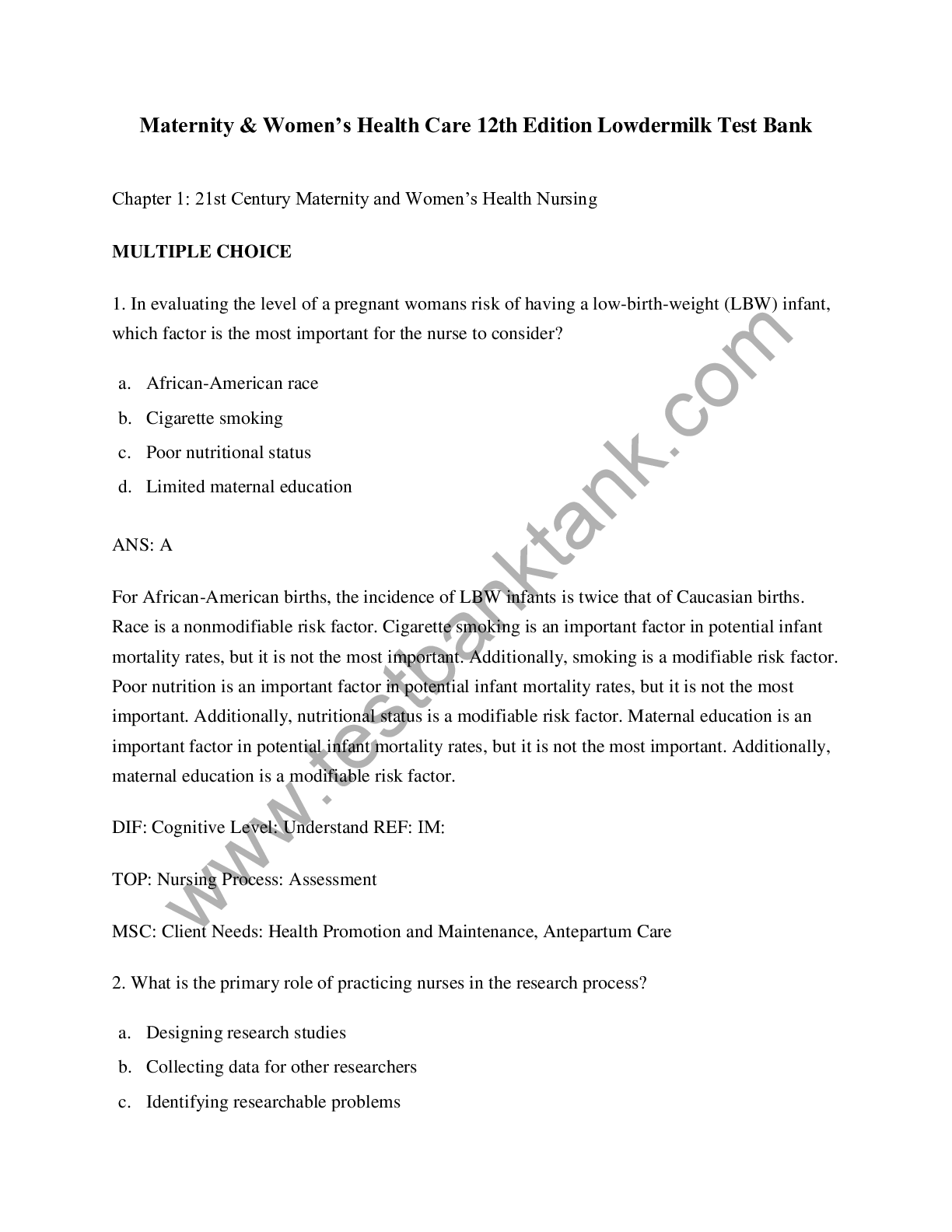

.png)
